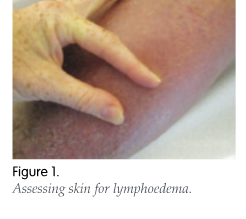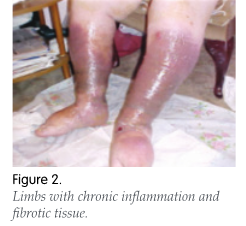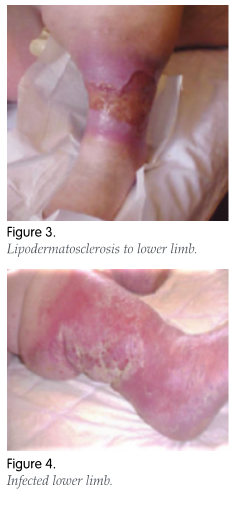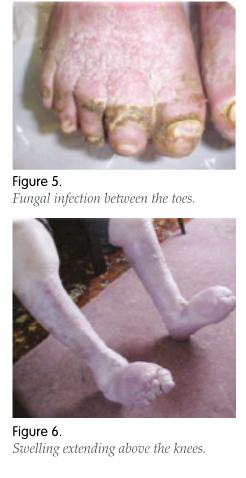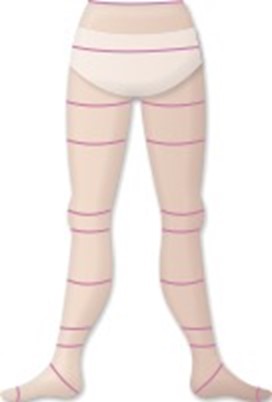References
All Party Parliamentary Group (2019) Venous Leg Ulcers: A silent crisis. Available online: www.legclub.org/uploads/documents/b69cedd6ff0d355ce6c350db261af296.pdf
Bianchi J, Vowden, K, Whittaker J (2012) Chronic odemea made easy. Wounds UK 8(2).
Bjork R (2013) Positive Stemmer’s sign yields a definitive lymphedema diagnosis in 10 seconds or less. Wound Care Advisor 2(2):10–14
Bjork R, Hettrick H (2018) Emerging paradigms integrating the lymphatic and integumentary systems: clinical implications. Wound Care Hyberbaric Med 9(2): 15–21
British Lymphology Society (2019) Position Paper for Ankle Brachial Pressure Index (ABPI). Informing Decision-making before the Application of Compression Therapy.
Carradice D (2020) Addressing the silent crisis of venous leg ulcers and its impact on patients. Available online: https://venousnews.com/addressing-the-silent-crisis-of-venous-leg-ulcers-and-its-impact-on-patients/
Casley-Smith J, Casley-Smith JR (1997) Modern Treatment for Lymphoedema. 5th edn. Terrace Printing, Adelaide, Australia
Charles H (1995) The impact of leg ulcers on patients’ quality of life. Prof Nurs 10(9): 571–3
Clinical Resource Efficiency Support Team NI (1998) Guidelines for the Assessment and Management of Leg Ulceration.CREST Secretariat
Doherty DC, Morgan PA, Moffatt CJ (2006) Role of hosiery in lower limb Lymphoedema. In: Lymphoedema Framework. Template for Practice: Compression Hosiery in Lymphoedema. MEP Ltd, London: 10–21
Ellis M (2015) Lymphovenous disease and its effect on the lower limb. J Community Nurs 29(1): 32–40
European Society of Cardiology (2011) ESC Guidelines on the diagnosis and treatment of peripheral artery diseases: Document covering atherosclerotic disease of extracranial carotid and vertebral, mesenteric, renal, upper and lower extremity arteries. Eur Heart J 32(22): 2851–2906
Farrow W (2010) Phlebolymphedema: a common underdiagnosed and undertreated problem in the wound care clinic. J Am Col Certif Wound Spec 2(1): 14–23
Fife C, Carter M (2009) Lymphoedema in bariatric patients. J Lymphoedema 4(2): 29–37
Green T (2007) Leg ulcer management in patients with chronic oedema. Wound Essentials 2: 46–58
Guest JF, Ayoub N, McIlwraith T, et al (2016) Health economic burden that different wound types impose on the UK’s National Health Service. Int Wound J 14(2): 322–30
Guest JF, Fuller GW, Vowden P (2020) Cohort study evaluating the burden of wounds to the UK’s National Health Service in 2017/2018: update from 2012/2013. BMJ Open 10: e045253
Gulliford M, Naithani S, Morgan M (2006) What is ‘continuity of care’? J Health Serv Res Policy 11(4): 248–50
Harding KG (2006) Trends in wound care – the development of a specialty. Int Wound J 3: 147
Humphreys J, Thomas M, Morgan K (2017) Managing chronic oedema in community settings. Wounds UK 13(3): 22-35
Keeley V (2008) Drugs that may exacerbate and those used to treat lymphoedema. J Lymphoedema 3(1): 57–65
Keeley V (2009) Chronic oedema of the lower limb: causes, presentation and management priorities. In: Skills for Practice: Management of Chronic Oedema in the Community. Wounds UK, Aberdeen
Kjaer ML, Sorensen LT, Karlsmark T, Mainz J, Gottrup F (2005) Evaluation of the quality of venous leg ulcer care given in a multidisciplinary specialist centre. J Wound Care 14(4): 145–50
Lymphoedema Framework (2006) Best Practice for the Management of Lymphoedema. International consensus. MEP, London
Mandal A (2006) The concept of concordance and its relation to leg ulcer management. J Wound Care 18(8): 339–41
Moffatt CJ, Franks PJ, Doherty DC, et al (2003) Lymphoedema: an underestimated health problem. QJM 96(10): 731–8
Moffatt CJ, Aubeeluck A, Franks PJ, et al (2017) Psychological factors in chronic edema: a case-control study. Lymphat Res Biol 15(3): 252–61
Moore Z, Dowsett C, Smith G, et al (2019)TIME CDST: an updated tool to address the current challenges in wound care. J Wound Care 28(3): 154–61
Morgan A, Moffatt CJ (2008) Non-healing leg ulcers and the nurse–patient relationship. Part 1: the patient’s perspective. Int Wound J 5(2): 340–48
Morgan K, Thomas L (2018) The development of a ‘wet leg’ pathway for chronic oedema. Int J Palliat Care 24(1): 40–6
Mortimer P, Browse N (2003) The relationship between the Iymphatics and chronic venous disease. In: Browse N, Burnand KG, Mortimer PS. Diseases of the Lymphatics. Arnold, London: 293-6
Mortimer PS, Rockson SG (2014) New developments in clinical aspects of lymphatic disease. J Clin Invest 124(3): 915–21
Murdoch V (2020) Inappropriate use of diuretics and antibiotics for wet or ‘leaky’ legs. J Community Nurs 34(4): 58–62
National Institute for Health and Care Excellence (2013) Varicose veins: diagnosis and managment. NICE, London. Available online: www.nice.org.uk/guidance/cg168
Newton H (2011) Chronic oedema of the lower limb: pathophysiology and management. Br J Community Nurs 16(4): S4–12
Opuku F (2015) Ten top tips: improving the diagnosis of cellulitis in the lower limb. Wounds Int 6(1): 4–9
Rabe E, Hertel S, Bock E, et al (2013) Therapy with compression stockings in Germany — results from the Bonn Vein Studies. J Dtsch Dermatol Ges 11(3): 257–61
Raymond R, Flanaghan M (2017) Chronic oedema: treatment and the impact of prescribed medicines. Pharmaceutical J online, 7 June. Available online: https://pharmaceutical-journal.com/article/ld/chronic-oedema-treatment-and-the-impact-of-prescribed-medicines
Royal College of Nursing (1998) The Management of Patients with Venous Leg Ulcers. RCN, London
Scottish Intercollegiate Guidelines Network (1998) The Care of Patients with Chronic Leg Ulcers. SIGN, Edinburgh
Stanton J, Hickman A, Rouncivell D, et al (2016) Promoting patient concordance to support rapid leg ulcer healing. J Community Nurs 30(6): 28–35
Todd M (2014) Strategies to prevent the progression of venous and lymphovenous disease. Br J Community Nurs 17(Sup9b): 3–14
Todd M (2016) The challenges of caring for people with chronic oedema. Nurs Res Care 18(4): 198–200
Wigg J (2016) Fluoroscopy guided manual lymphatic drainage from research to the classroom. International Lymphoedema Framework Conference/Australasian Lymphology Association Conference
Williams A (2009) Chronic oedema in patients with CVI and ulceration of the lower limb. Br J Community Nurs 14(10): S4–8
Wound Care People (2019) Best practice in the community. Chronic oedema. Wound Care People, Wixford. Available online: www.jcn.co.uk
Wounds UK (2009) Skills for Practice: Management of Chronic Oedema in the Community. Wounds UK, Aberdeen
Wounds UK (2014) Managing chroinc oedema with a venous leg ulcer — A quick guide. Wounds UK, London
Wounds UK (2016) Holistic management of venous leg ulceration. Wounds UK, London.
Wounds UK (2019) Best Practice Statement: Addressing complexities in the management of venous leg ulcers. Wounds UK, London.
Bianchi J, Vowden, K, Whittaker J (2012) Chronic odemea made easy. Wounds UK 8(2).
Bjork R (2013) Positive Stemmer’s sign yields a definitive lymphedema diagnosis in 10 seconds or less. Wound Care Advisor 2(2):10–14
Bjork R, Hettrick H (2018) Emerging paradigms integrating the lymphatic and integumentary systems: clinical implications. Wound Care Hyberbaric Med 9(2): 15–21
British Lymphology Society (2019) Position Paper for Ankle Brachial Pressure Index (ABPI). Informing Decision-making before the Application of Compression Therapy.
Carradice D (2020) Addressing the silent crisis of venous leg ulcers and its impact on patients. Available online: https://venousnews.com/addressing-the-silent-crisis-of-venous-leg-ulcers-and-its-impact-on-patients/
Casley-Smith J, Casley-Smith JR (1997) Modern Treatment for Lymphoedema. 5th edn. Terrace Printing, Adelaide, Australia
Charles H (1995) The impact of leg ulcers on patients’ quality of life. Prof Nurs 10(9): 571–3
Clinical Resource Efficiency Support Team NI (1998) Guidelines for the Assessment and Management of Leg Ulceration.CREST Secretariat
Doherty DC, Morgan PA, Moffatt CJ (2006) Role of hosiery in lower limb Lymphoedema. In: Lymphoedema Framework. Template for Practice: Compression Hosiery in Lymphoedema. MEP Ltd, London: 10–21
Ellis M (2015) Lymphovenous disease and its effect on the lower limb. J Community Nurs 29(1): 32–40
European Society of Cardiology (2011) ESC Guidelines on the diagnosis and treatment of peripheral artery diseases: Document covering atherosclerotic disease of extracranial carotid and vertebral, mesenteric, renal, upper and lower extremity arteries. Eur Heart J 32(22): 2851–2906
Farrow W (2010) Phlebolymphedema: a common underdiagnosed and undertreated problem in the wound care clinic. J Am Col Certif Wound Spec 2(1): 14–23
Fife C, Carter M (2009) Lymphoedema in bariatric patients. J Lymphoedema 4(2): 29–37
Green T (2007) Leg ulcer management in patients with chronic oedema. Wound Essentials 2: 46–58
Guest JF, Ayoub N, McIlwraith T, et al (2016) Health economic burden that different wound types impose on the UK’s National Health Service. Int Wound J 14(2): 322–30
Guest JF, Fuller GW, Vowden P (2020) Cohort study evaluating the burden of wounds to the UK’s National Health Service in 2017/2018: update from 2012/2013. BMJ Open 10: e045253
Gulliford M, Naithani S, Morgan M (2006) What is ‘continuity of care’? J Health Serv Res Policy 11(4): 248–50
Harding KG (2006) Trends in wound care – the development of a specialty. Int Wound J 3: 147
Humphreys J, Thomas M, Morgan K (2017) Managing chronic oedema in community settings. Wounds UK 13(3): 22-35
Keeley V (2008) Drugs that may exacerbate and those used to treat lymphoedema. J Lymphoedema 3(1): 57–65
Keeley V (2009) Chronic oedema of the lower limb: causes, presentation and management priorities. In: Skills for Practice: Management of Chronic Oedema in the Community. Wounds UK, Aberdeen
Kjaer ML, Sorensen LT, Karlsmark T, Mainz J, Gottrup F (2005) Evaluation of the quality of venous leg ulcer care given in a multidisciplinary specialist centre. J Wound Care 14(4): 145–50
Lymphoedema Framework (2006) Best Practice for the Management of Lymphoedema. International consensus. MEP, London
Mandal A (2006) The concept of concordance and its relation to leg ulcer management. J Wound Care 18(8): 339–41
Moffatt CJ, Franks PJ, Doherty DC, et al (2003) Lymphoedema: an underestimated health problem. QJM 96(10): 731–8
Moffatt CJ, Aubeeluck A, Franks PJ, et al (2017) Psychological factors in chronic edema: a case-control study. Lymphat Res Biol 15(3): 252–61
Moore Z, Dowsett C, Smith G, et al (2019)TIME CDST: an updated tool to address the current challenges in wound care. J Wound Care 28(3): 154–61
Morgan A, Moffatt CJ (2008) Non-healing leg ulcers and the nurse–patient relationship. Part 1: the patient’s perspective. Int Wound J 5(2): 340–48
Morgan K, Thomas L (2018) The development of a ‘wet leg’ pathway for chronic oedema. Int J Palliat Care 24(1): 40–6
Mortimer P, Browse N (2003) The relationship between the Iymphatics and chronic venous disease. In: Browse N, Burnand KG, Mortimer PS. Diseases of the Lymphatics. Arnold, London: 293-6
Mortimer PS, Rockson SG (2014) New developments in clinical aspects of lymphatic disease. J Clin Invest 124(3): 915–21
Murdoch V (2020) Inappropriate use of diuretics and antibiotics for wet or ‘leaky’ legs. J Community Nurs 34(4): 58–62
National Institute for Health and Care Excellence (2013) Varicose veins: diagnosis and managment. NICE, London. Available online: www.nice.org.uk/guidance/cg168
Newton H (2011) Chronic oedema of the lower limb: pathophysiology and management. Br J Community Nurs 16(4): S4–12
Opuku F (2015) Ten top tips: improving the diagnosis of cellulitis in the lower limb. Wounds Int 6(1): 4–9
Rabe E, Hertel S, Bock E, et al (2013) Therapy with compression stockings in Germany — results from the Bonn Vein Studies. J Dtsch Dermatol Ges 11(3): 257–61
Raymond R, Flanaghan M (2017) Chronic oedema: treatment and the impact of prescribed medicines. Pharmaceutical J online, 7 June. Available online: https://pharmaceutical-journal.com/article/ld/chronic-oedema-treatment-and-the-impact-of-prescribed-medicines
Royal College of Nursing (1998) The Management of Patients with Venous Leg Ulcers. RCN, London
Scottish Intercollegiate Guidelines Network (1998) The Care of Patients with Chronic Leg Ulcers. SIGN, Edinburgh
Stanton J, Hickman A, Rouncivell D, et al (2016) Promoting patient concordance to support rapid leg ulcer healing. J Community Nurs 30(6): 28–35
Todd M (2014) Strategies to prevent the progression of venous and lymphovenous disease. Br J Community Nurs 17(Sup9b): 3–14
Todd M (2016) The challenges of caring for people with chronic oedema. Nurs Res Care 18(4): 198–200
Wigg J (2016) Fluoroscopy guided manual lymphatic drainage from research to the classroom. International Lymphoedema Framework Conference/Australasian Lymphology Association Conference
Williams A (2009) Chronic oedema in patients with CVI and ulceration of the lower limb. Br J Community Nurs 14(10): S4–8
Wound Care People (2019) Best practice in the community. Chronic oedema. Wound Care People, Wixford. Available online: www.jcn.co.uk
Wounds UK (2009) Skills for Practice: Management of Chronic Oedema in the Community. Wounds UK, Aberdeen
Wounds UK (2014) Managing chroinc oedema with a venous leg ulcer — A quick guide. Wounds UK, London
Wounds UK (2016) Holistic management of venous leg ulceration. Wounds UK, London.
Wounds UK (2019) Best Practice Statement: Addressing complexities in the management of venous leg ulcers. Wounds UK, London.



